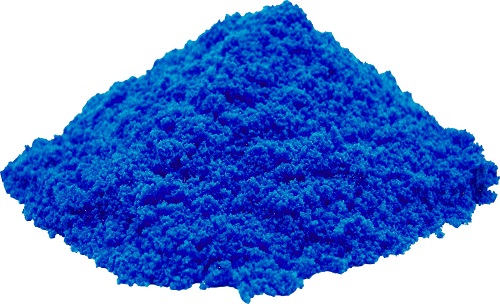Vanadiumoxidsulfat Chemische Eigenschaften,Einsatz,Produktion Methoden
R-S?tze Betriebsanweisung:
R22:Gesundheitssch?dlich beim Verschlucken.
R36/38:Reizt die Augen und die Haut.
S-S?tze Betriebsanweisung:
S26:Bei Berührung mit den Augen sofort gründlich mit Wasser abspülen und Arzt konsultieren.
S36/37/39:Bei der Arbeit geeignete Schutzkleidung,Schutzhandschuhe und Schutzbrille/Gesichtsschutz tragen.
Chemische Eigenschaften
Vanadyl sulfate is a pale blue crystalline powder. It is odorless and very soluble in water. It is denser than water. Contact may irritate skin, eyes, and mucous membranes. It may be toxic if ingested, inhaled, or absorbed through the skin.

Physikalische Eigenschaften
The dihydrate, VOSO
4.2H
2O is a blue black crystalline powder, soluble in water.
synthetische
Vanadyl sulfate is prepared by passing sulfur dioxide through a cold solution of vanadium pentoxide in sulfuric acid, followed by crystallization:
V2O5 + H2SO4 + H2O + SO2 → 2VOSO4 + 2H2O
Allgemeine Beschreibung
Vanadyl sulfate is a sulfate of vanadium that occurs naturally as the mineral pauflerite. It is a common source of vanadium in the laboratory. Vanadyl sulfate is an intermediate in the extraction of vanadium from petroleum residues and is also a component of some food supplements and drugs. Vanadium is a transition metal with the chemical symbol V and atomic number 23. The element usually combines with other elements such as oxygen, sodium, sulfur, or chloride, and occurs naturally in about 65 different minerals and in fossil fuel deposits. Vanadium is found in many organisms, and is used by some life forms as an active center of enzymes. (L837, L838, L852)
Reaktivit?t anzeigen
Vanadyl sulfate has weak oxidizing or reducing powers. Redox reactions can however still occur.
Health Hazard
Highly toxic, may be fatal if inhaled, swallowed or absorbed through skin. Avoid any skin contact. Effects of contact or inhalation may be delayed. Fire may produce irritating, corrosive and/or toxic gases. Runoff from fire control or dilution water may be corrosive and/or toxic and cause pollution.
Brandgefahr
Non-combustible, substance itself does not burn but may decompose upon heating to produce corrosive and/or toxic fumes. Containers may explode when heated. Runoff may pollute waterways.
Nebenwirkungen
Commonly reported side effects of vanadyl sulfate include gastrointestinal issues such as nausea, diarrhea, and stomach cramps. These mild side effects tend to subside with continued use or dose adjustment. However, they can be bothersome and might deter some individuals from using the supplement. More serious risks, though rare, include toxicity from excessive intake. High doses of vanadium compounds can lead to issues such as liver and kidney damage. Therefore, it’s essential to adhere to recommended dosages and avoid excessive use.
Sicherheitsprofil
A poison and an
inhalation hazard. Poison by intravenous,
intraperitoneal, and subcutaneous routes.
Mutation data reported. When heated to
decomposition it emits toxic fumes of VOx
and SOx. See also SULFATES and
VANADIUM COMPOUNDS.
m?gliche Exposition
Vanadyl sulfate is used as a fixative
for textile dyes, a colorant for glass and ceramics; a reducing
agent and a catalyst.
Versand/Shipping
UN2931 Vanadyl sulfate, Hazard Class: 6.1;
Labels: 6.1-Poisonous materials.
Inkompatibilit?ten
Vanadyl sulfate has weak oxidizing or
reducing powers. Redox reactions can however still
occur. Incompatible with oxidizers (chlorates, nitrates,
peroxides, permanganates, perchlorates, chlorine, bromine,
fluorine, etc.); contact may cause fires or explosions. Keep
away from alkaline materials, strong bases, strong acids,
oxoacids, epoxides. Vanadyl sulfate may attack metals; sulfates
react with aluminum, magnesium.
Vanadiumoxidsulfat Upstream-Materialien And Downstream Produkte
Upstream-Materialien
Downstream Produkte

